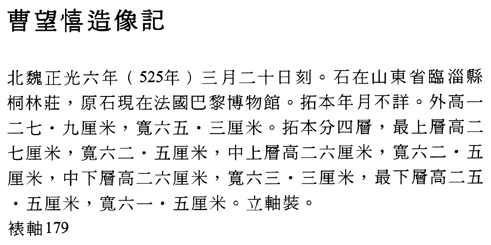 |
|
|
 |
|
|
Inscription and
Illustrated Panels for the Base of a Buddhist Image Constructed by Cao Wangxi Northern
Wei dynasty (386�534), Zhengguang reign period (519�24), dated 525 Hanging
scroll, ink rubbed on paper; 127.9 x 65.3 cm; rubbing at uppermost register:
approx. 27.0 x 62.5 cm; rubbing at upper middle register: approx. 26.0 x 62.5
cm; rubbing at lower middle register: approx. 26.0 x 63.3 cm; rubbing at
lowermost register: approx. 25.5 x 61.5 cm Date
of rubbing not given, probably Qing dynasty (1644�1911) Inventory number: Biaozhou 179 These
four rubbings were taken from the sides of a stone pedestal supporting a
Buddhist image commissioned by Cao Wangxi.�
The principal panel depicts Maitreya (Sanskrit for "the Merciful
One"), the Buddha of the Future, whose anticipated coming four thousand
years after Sakyamuni Buddha's attained nirvana, would presage the arrival of
paradise on earth. The
three pictorial sides were carved in relief with flowing, rhythmic lines, hence
the images on the rubbing appear as positive rather than the usual negative
forms.� The inscription was engraved in
intaglio in 22 columns of regular script, with a maximum of nine characters per
column.� As with most Northern Wei
inscriptions, there are a number of variant characters that do not have modern
equivalents.� The inscription also
supplies the precise date upon which the image of Maitreya was dedicated, lists
Cao Wangxi's official positions, and states his purpose for commissioning the
work. |
 |